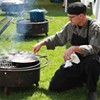Published November 5, 2008 at 6:13 a.m.
In the whir and blur of the YouTube era, the magnetic intrigue of historical photographs can be forgotten. Montpelier: Images of Vermont’s Capital City is an informative and enjoyable new volume on the flinty town that serves as the country’s smallest seat of government. The compact paperback contains mostly black-and-white photographs, with a small selection of color photos and postcards — 245 pictures in total. Archival images testify to buildings that have changed or disappeared, and long-departed subjects whose voices seem to echo through the camera’s lens.
Vermont Historical Society librarian Paul Carnahan and co-author Bill Fish mined the society’s extensive collection of photographs for raw material. Several publishers expressed interest in a pictorial town history, in part because no book had been published about the capital city in more than 30 years.
To “keep it manageable,” Carnahan says, the VHS remained the project’s primary source. The organization has “a particularly strong collection of Montpelier photographs because we’ve been in Montpelier since our founding in 1836,” he notes. In addition, his day job — as the librarian helping researchers navigate the archives — gave him deep knowledge of what their bulging files contain. (In the end, the authors did add a few photos from the state archives and University of Vermont Special Collections.)
Carnahan and Fish hunted carefully for lots of early images. They reproduce the first known representation of the town, an 1821 woodcut. The book also includes the only surviving pictures — daguerrotypes — of the short-lived second statehouse, which burned down in 1857.
There are several reasons Carnahan and Fish picked 1940 as the cutoff date for photos. For one, the VHS collection for the subsequent period is not as strong, Carnahan says. Also, he feels Vermont’s post-World War II history is already better known. Personal background played a role in their decision, too. Although both authors now live in Montpelier, neither grew up there. “We realized that . . . there are a lot of people around who knew the history from 1940 to the present much better than we did,” Carnahan admits.
These self-imposed parameters help make the book cohesive and concise. The other key was organizing the photos thematically, rather than chronologically. Chapters center on civic, economic and religious life, and on transportation, entertainment and natural disasters. Each section’s text does more than merely introduce a set of arresting images. The authors have written an engaging history of the town, swiftly told and studded with telling details about its architecture and citizens.
The chapter on economic life, for example, traces a brief timeline of the arrivals of major businesses and industries in town. It shows how Montpelier’s “versatile mix . . . allowed it to prosper through the good times and weather the bad times.” Photos capture aspects of the town that modern life has rendered obsolete. Entire lines of work, such as ice storage and delivery and wooden clothespin manufacturing, have disappeared. Factories once hugged the riverbank precariously — their backs constructed right up to the water’s edge — because they relied on hydropower.
Both Montpelier buildings and people proved resilient in the face of fires, floods and obstacles posed by the town’s geography. One remarkable custom that flourished in the late 19th and early 20th centuries was relocating and repurposing structures rather than demolishing them. Townspeople used oxen and hand tools to accomplish moves that would still pose considerable challenges today. Some buildings even made river crossings to get to their new homes.
Carnahan won’t hazard a guess as to whether moving rather than razing old buildings happened more often in Montpelier than in other towns. “I certainly suspect Vermonters did it more often,” he says. “Vermonters and Montpelierites weren’t trying to change the scale of the city dramatically, so these buildings were still useful . . . I think it certainly was part of the frugality of the period.” In large cities such as Chicago, he explains, “The drive to build bigger and taller all the time certainly cost that city a lot in its architectural and built heritage.”
One result: Montpelier has Vermont’s largest district on the National Register of Historic Places. It encompasses the downtown center and adjacent neighborhoods and includes 576 structures. “It’s really a great asset to us that so many buildings were preserved either by moving or by changing, without obliterating the building entirely,” Carnahan reflects. “It definitely contributes to the feeling of the city and the character of the city.” His favorite? James French’s oft-moved 1861 post office, which has also served as a dry-goods store and garage. “It’s sort of a cat with nine lives,” he jokes. It now rests near city hall.
Although the book thoroughly documents Montpelier’s architectural history, the photographs that resonate most powerfully are the images of townspeople. Hoop-skirted ladies play a summertime croquet match. High school football champs strike a macho action pose. Bowler-hatted onlookers line a snow-covered East State Street as sledders race past the Paper Box Factory. Grade-schoolers in crisp pinafores gather around a maypole. Pride — civic and personal — seems to be the common thread.
That these images are captured in black and white gives them a wonderful sense of permanence. It also reminds us how remote and unfamiliar the life documented by the photos has become. While the horses and trolleys are gone, however, the pride remains.
Info:
Montpelier: Images of Vermont’s Capital City by Paul A. Carnahan and Bill Fish. The History Press, 128 pages. $19.99.
More By This Author
Speaking of...
-

Review of Sen. Patrick Leahy's New Memoir
Aug 26, 2022 -

Book Review: Pete the Cat and His Magic Sunglasses
May 27, 2016 -

Book Review: Penguin Cha-Cha
Mar 31, 2016 -

Book Review: Dog vs. Cat
Dec 16, 2015 -

Book Review: The Hummingbird by Stephen P. Kiernan
Nov 4, 2015 - More »
Comments
Comments are closed.
From 2014-2020, Seven Days allowed readers to comment on all stories posted on our website. While we've appreciated the suggestions and insights, right now Seven Days is prioritizing our core mission — producing high-quality, responsible local journalism — over moderating online debates between readers.
To criticize, correct or praise our reporting, please send us a letter to the editor or send us a tip. We’ll check it out and report the results.
Online comments may return when we have better tech tools for managing them. Thanks for reading.













































